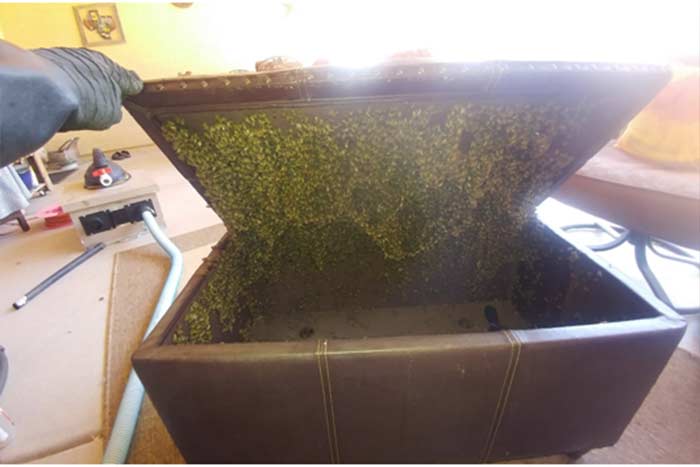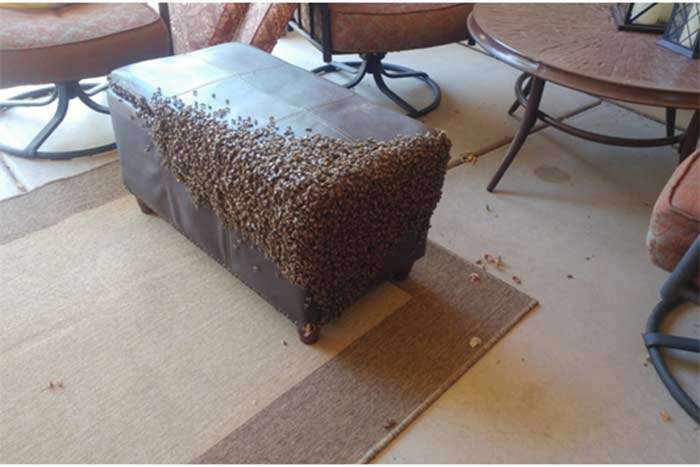
Bee & Honeycomb Removal from Upholstered Chest in Phoenix, AZ
Last week a homeowner in Phoenix, AZ called. He reported the presence of honeybees in an upholstered chest in his backyard. He told us that there was bee activity in and out of the chest for several months; he decided to do nothing because the bees were not bothering him or his neighbors. Finally, as the months passed, he noticed that the amount of bee traffic had increased dramatically. Surprisingly they were not bothering him or his dog. One day, he as running his weed eater and the bees chased him off and gave him a few stings.
Bee Removal Options
Live Bee Removal
Our customer and his wife discussed it and decided that, for safety reasons, it was best to remove the bees to protect themselves and their dog. They really wanted to save the bees, so they called around to several companies and found that most of them exterminate the bees. When they called Kyles Bee Removal, they were pleasantly surprised that we can perform a live removal most of the time, depending on circumstances. Live bee removal is best suited to situations where the bees are fully exposed or when we can open up their nesting spot. They decided to hire us to come out and remove the bees that same day.
We arrived at the customer’s home about one hour later and thoroughly inspected the location of bee activity. We also did visual inspection of neighboring yards to verify that there were no people or pets that needed to be protected during bee removal. After our inspection, we notified them that we could perform “live removal” at this location. Our decision for live removal was based on the fact that the bees were not aggressive, the neighboring yards did not have people or pest at the time, and the upholstered chest could be opened to expose the bees and their honeycomb.
After our customer gave approval to proceed, we began the process of live bee removal. First, we set up our equipment, including a special vacuum that does not damage the bees. Then we opened the chest lid and began vacuuming the bees and their queen into the capture box. Now, they were ready for transport to our bee farm. Our technician removed all the honeycomb so that other bees would not be attracted to and take up residence in the same location. After bagging the honeycomb for disposal and cleaning up the site, we transported the bees to their new home. Hooray!
Our customer was happy we were able to save the bees for the same cost as extermination, even though live removal generally takes more time, expertise, and specialized equipment.
In some instances, live bee removal costs more than extermination depending on the location of the bees and the difficulty of the job.
Extermination
Unfortunately, bee extermination is occasionally the safest method to remove bees. This is because virtually all honey bees in Phoenix and the surrounding cities are Africanized. Sometimes, if the bees are disturbed, they will sting any person or animal that is nearby. We have experienced many jobs where, upon our arrival, the bees have been disturbed and were stinging any person or animal within 75 yards of their hive. In cases like this, we must exterminate the bees to protect people and their pets. In situations where the honey bees have made their nest inside an attic or other structure, live removal may not be possible; the vibration, noise, and human presence required to cut open a roof or wall may cause large numbers of bees to sting as part of their defensive behavior. Bees react differently from day to day and in different circumstances. Therefore, our highly trained technicians must carefully evaluate the situation and make one or more recommendations to our customers based on their observations and conclusions about the safety of the situation. In some circumstances, where a live removal is mandatory, it can be performed at night rather than during the day; additional charges may apply for night work.
Why do Honey Bees Sting?
When honey bees, and especially Africanized bees, sense a threat from what they perceive as a predator (human, bear, skunk, dog, or some other animal), they behave to defend their colony. Africanized bees often display strong defensive behavior, and sting in large numbers (hundreds or thousands). As they sting their victim, the stinger is embedded in the skin or clothing leaving a strong “sting scent” odor. The other bees smell this “sting scent,” become excited, and join in on the stinging around the spot of the stinger(s). If the number of stings is too great, the victim may die.
Tags: Africanized bees, agressive bees, bee activity, bee sting, Honey Bees, Upholstered ChestCategories: Bee Removal

